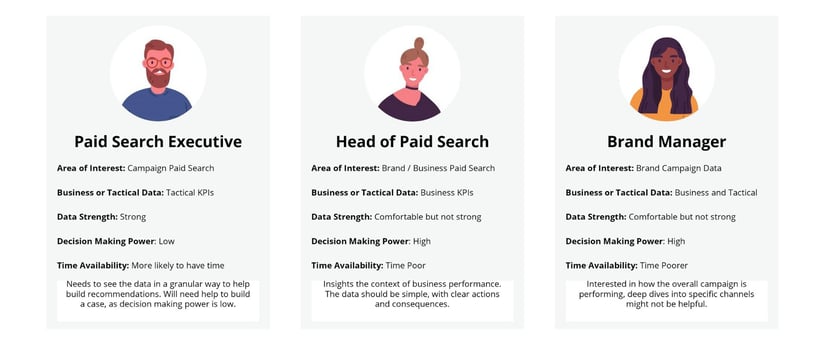Data storytelling is an essential skill for marketers. However, data storytelling within organizations, especially big ones, can be a challenge. Often insights can be overlooked because they have been communicated to the wrong people, in the wrong way, at the wrong time.
In this post, we explore what data storytelling is and our three steps for building an effective data storytelling strategy within a business that will ensure your data and insights are being seen and, more importantly, used to drive decision-making.
Check out our full agency guide to data storytelling!
What is Data Storytelling?
Data storytelling is the ability to communicate insights through data that lead to actions that will positively affect the business.
The measurement of success for effective data storytelling however is not simply the act of sharing insights - but that actions are taken because of these insights. For example, as a marketer, data storytelling means being able to show how your marketing performance is impacting sales and then using those insights to enable better planning and optimization of not only your marketing campaigns but as a strategic revenue driver across the business from sales strategy to logistics.
The Importance of Data Storytelling in Marketing
Brent Dykes, the author of the bestselling book “Effective Data Storytelling: How to Drive Change with Data, Narrative, and Visuals”, writes:
“Throughout my data career, I’ve often compared analytics to a marathon. The finish line for the data analytics marathon is slightly different than that of regular races. There are no cheering crowds, no finish line ribbons, and no fancy medals—your reward is the business value you generate from your data.”
- Brent Dykes
And indeed, data analytics is a long-distance run that, for the most part, consists of data collection, preparation, and visualization. Only in the last mile do we get to conduct data analysis and communicate insights. And, just as with a race, that last sprint is just as important as a good start. Without adequate data storytelling, all that effort put into collecting, analyzing, and drawing insights from your data is ultimately worthless.
Moreover, for any business, there are huge benefits to having effective data storytelling between and within departments. Firstly, data storytelling facilitates a data-driven marketing approach which means using insights to inform key strategic and tactical decisions that will have a positive impact on the business.
At the same time, sharing data and insights, especially those that work, will help encourage a more data and insights-driven culture within the business, further encouraging more insights that positively impact the business, in turn driving a more data-driven culture, which in turn encourages more data sharing…in an endless but virtuous positive feedback loop!
Nonetheless, in order to get the most out of your data sharing, it is important to have an effective data storytelling strategy.
Tired of reading? Watch the video instead!
3 steps for building an effective data storytelling strategy
Step 1. Know your Audience
Regardless of the gravity of the insight you are trying to share, the wrong methodology and language can have a massive impact on how it is received. Sharing information with the wrong person, or with the right person but in a way that they do not understand, could lead to no action being taken and opportunities lost.
Therefore, knowing your audience is vital to ensuring that your insights are seen, understood, and acted upon. For that reason, you will need to think about the several types of people within the business, the type of insights they will care about, the kind of language that will grab their attention, and the amount of time they have to receive and act upon insights.
In order to carry out this process properly, ask the following questions:
About your audience:
- Are they time-poor or time rich?
- Are they decision-makers or do they carry out other people’s decisions?
- Are they data savvy or new to data and analytics?
- Do they need to see business-related metrics or tactical KPIs?
- Have they been historically engaged with data, or have they been more ambivalent?
- Does your team have time to create more time-intensive materials?
- Is your team empowered to decide which method should be used?
- How data savvy is your team and what kind of insights could they find?

Building audience profiles will greatly improve the effectiveness of your data storytelling
Step 2. Picking the Right Methods
There are a number of methods you can use to get the right stories into the hands of your stakeholders. You can use each of them to achieve your goals, but you need to be aware of their advantages and disadvantages.
The methods you choose to employ will largely depend on the audiences within your business you are trying to reach. But remember; there is no one-size-fits-all approach. Different people will respond better to different methods, so aim to include at least three or four different types.
It’s also crucial to consider how regularly you want to share insights and with which method. Regular reporting, for example, on a weekly/bi-weekly/monthly/quarterly basis establishes a good routine on which you can build further. But be careful. The regular cadence of your reporting can put you in a state where additional insights are not queried often enough, leaving undiscovered nuggets of information within your organization.
At the same time, data summits are great for building that data-driven culture within the company, as are infographics and regular newsletters, but consider how much time and effort they will take compared to the value you will get out of them.
Tip: Explore different data storytelling methods and their pros and cons in our blog post: Top 8 Data Storytelling Methods
Step 3: Keeping Track
To continually improve the data and insights you’re sharing, it is important to keep track of the impact they’ve had on various aspects of your business. Measuring how your insight landed, and the effect it had, will enable you to improve your processes in the future, and further develop the data-driven culture in your business.
Tracking your insights will also help to identify success stories and case studies, which can be used to prove the value of the insights-sharing initiative.
So, what should you keep track of? Not much, only six things:
- What was shared?
- How did we share it?
- Who was it shared with?
- How was it received?
- Did they take our recommended action?
- What was the effect of this action?
Based on that, you can track your progress with:
Surveys
Capture feedback regarding specific aspects of your data and insight-sharing program. Surveys can be used to gauge your audience’s feelings towards specific parts of your program, and to help shape what you present to them in the future.
Hard metrics
Monitor the performance of some elements of your data and insights sharing program: email open rates, email engagements, dashboard usage metrics, and webinar attendances.
Insight success tracker
Track the impact of the data and insight that you have shared and determine what was the insight, how was it received, what the action taken was, what was the result, and could a case study be built.
Tip: We've made an Adverity Insights Success Tracker Template so you don't have to!
Of course, if you are using a platform like Adverity, whether you use surveys, metrics, the insights success tracker, or all three, you can bring all this data into one place and even combine it with other data sources for even more insights.
There is No Right or Wrong Way
Insight plays a crucial role in a business becoming data-driven and it is therefore fundamentally important to ensure an effective strategy for sharing insights and data throughout the company. And, while there are many ways for a business to share insights, there is no one size fits all approach - each business will have its own unique needs and approaches depending on its size, culture, people, etc.
However, it is important to remember that this is a marathon, not a sprint. Do not expect instant results immediately and feel disheartened when you don’t get them. An effective data storytelling strategy is a key component of a business’s journey on the road to analytical maturity. But this takes time.
Nonetheless, regardless of the current level you are at when it comes to sharing data and insights, the tips here will help you establish an effective strategy moving forward to help you in that race. Persevere and good luck!
Related Articles:
- Top 8 Data Storytelling Methods
- 4 Golden Rules for Dashboard Best Practice
- 20 Chart Types You Can Use to Visualize Your Data












